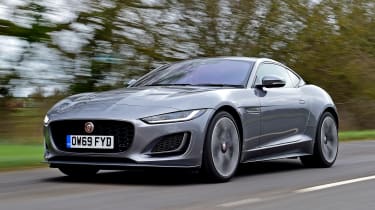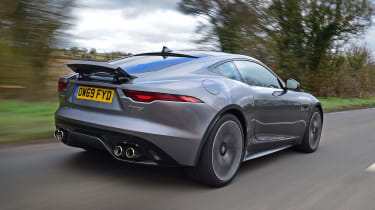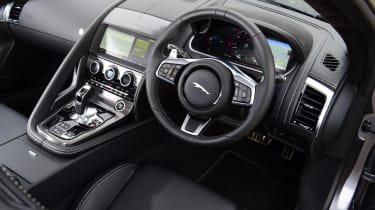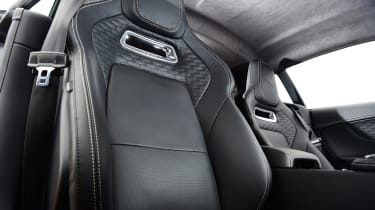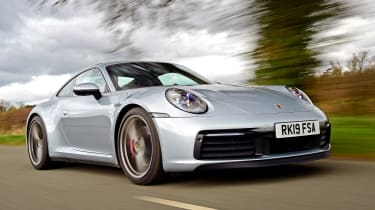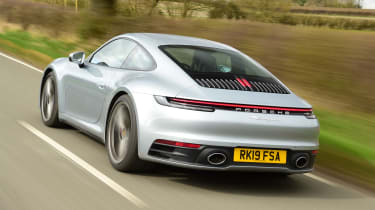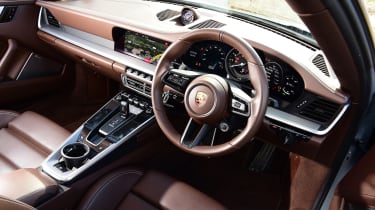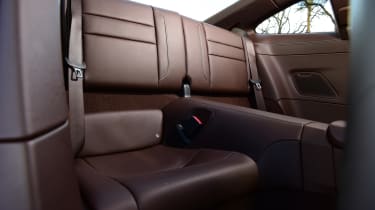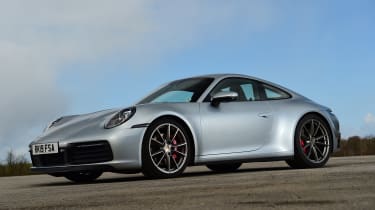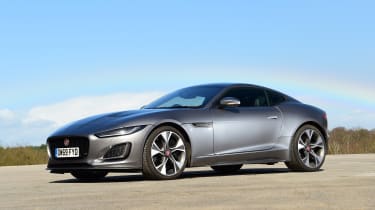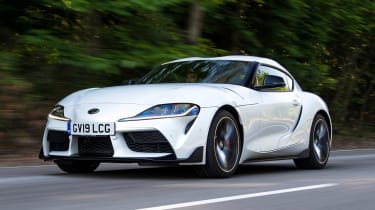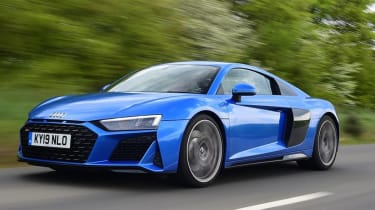Jaguar’s F-Type has usually come off second best when it’s taken on the Porsche 911. Can the newly facelifted car buck that trend?
The Jaguar F-Type has had updates in the past, but this is a big one. You can tell by the front-end styling that Jag has really gone to town with the design changes, while inside there’s more tech, too.
That’s because other sports cars that rival the Jaguar have constantly been evolved throughout their time on sale – or even replaced by new models – to keep buyers coming back for more. Now it’s the F-Type’s turn. The Convertible stole people’s hearts with its looks when it was launched in 2013, with the Coupé following a year later, so the styling updates are a big deal here.
Best performance cars 2020
What’s even more interesting is that Jaguar has dropped its supercharged V6 engine from the range, so now your only options are either a four-cylinder turbocharged motor or V8 power.
It’s the 444bhp V8 P450 we’re testing here in AWD (all-wheel drive) form, which puts it squarely in the sights of the 444bhp Porsche 911 Carrera 4S. These two models have done battle for the best part of a decade now, and the decision has usually fallen in favour of the 911. Does the updated F-Type have what it takes to redress the balance?
Jaguar F-Type
| Model: | Jaguar F-Type P450 AWD First Edition Coupé |
| Price: | £80,890 |
| Engine: | 5.0-litre supercharged V8, 444bhp |
| 0-60mph: | 4.1 seconds |
| Test economy: | 23.9mpg/5.3mpl |
| CO2: | 252g/km |
| Annual road tax: | £465 |
This updated P450 is an affordable way into one of the most characterful V8-engined sports cars around, with prices starting from £69,990. This rises to a chunkier £80,890 for this AWD First Edition model, yet that still undercuts the Porsche by quite some margin – but is that price gap obvious?
More reviews for F-Type
In-depth reviews
- Jaguar F-Type review
Road tests
- New Jaguar F-Type P450 2020 review
- New Jaguar F-Type facelift 2020 review
- New Lister LFT-C 2019 review
- New Jaguar F-Type Chequered Flag 2019 review
- Jaguar F-Type SVR 2017 review
- New Jaguar F-Type P380 2018 review
Used car tests
- Used Jaguar F-Type review
Design & engineering
While the F-Type has been fairly extensively updated, it’s not an all-new model like the ‘992’ Porsche 911 was last year. The Jag is still based on the same aluminium D6a platform, with double wishbones all round, and adaptive dampers as standard on this P450 AWD First Edition.
The name signifies the car’s power output, which stands at 444bhp. The 5.0-litre supercharged V8 also kicks out 580Nm of torque, so while the former is identical to the 911, highlighting these two cars as a natural pairing, the later is actually 50Nm more. Remember, though, that despite its use of aluminium, the F-Type does weigh 178kg more than the Porsche.
Power is sent to all four wheels through an eight-speed automatic transmission and there’s an electronic active differential with torque vectoring by braking at the rear to help improve agility.
Jaguar says the dynamics have been “tuned for exploitable performance and driver engagement”, which comes from suspension updates, a recalibrated steering set-up, a new subframe and tweaks to the active electronic differential.
What’s immediately more noticeable are the design differences. The headlights are now wide and shallow, there’s a new bonnet with cooling vents plus a revised front bumper and grille, too. This is the biggest visual change, although the tail-lights are now squarer in their design, and there are a few more pronounced, squared-off edges to the body panels. V8 cars retain their signature quad exhaust pipes.
Inside, the cabin design is familiar, with the same driver-focused environment sectioned off by a big grab handle, but all versions now get a 12.3-inch TFT dashboard display, which lifts the feel.
It gets Jag’s latest infotainment with improved smartphone connectivity, too, while First Edition models (based on R-Dynamic spec) have plenty of equipment, including leather sports seats, cruise and climate control, sat-nav and LED lights. Quality is fine, but still not at the Porsche’s level, because some of the plastics still don’t justify the price tag.
Driving
What does justify the cost is the engine. There are a few caveats to this, which we’ll come onto, but Jaguar’s venerable supercharged V8 is oozing with personality. Start it up and it settles from its initial busy idle to a tugboat-like whump-whump-whump noise, reminding you of the performance potential.
The switchable active exhaust now has a Quiet Start function so you don’t deafen your neighbours in the mornings, but the new F-Type has a petrol particulate filter, like all modern cars, and while the signature V8 bellow is present on full throttle, it’s certainly not as loud as before.
Also the crackles on the overrun are less effervescent than the barrage of rumbling and popping in older V8 F-Types, but there’s still no denying the appeal or the character on offer here.
The engine feels very under-stressed – because it is. Still, the 0-60mph time of 4.1 seconds is more than rapid enough, even if it trailed the Porsche’s effort. Where it did beat the 911 was from 50-70mph in the higher gears. The Jag’s margin of victory was by seconds in seventh and eighth, thanks to the swell of supercharged torque low down that hurls the car along relatively effortlessly.
Other improvements are noticeable, too. The ride feels more supple than before, and softer, and in some cases more comfortable than the 911’s. There’s also less road noise, something F-Types of old used to really suffer with. The steering feels more elastic and less direct than the Porsche’s, but it’s still a lovely weight and the rate of response is great; it inspires confidence and gives you a good connection with the front axle that lies out at the end of that long bonnet. That, in turn, brings us onto the next point: visibility.
Practicality
While it’s not a major consideration in a sports car, the Jag isn’t as practical compared with the 911. You don’t feel as confident placing the car, although standard parking sensors and a reversing camera come in handy.
The cabin also isn’t as spacious, while the F-Type is a strict two-seater. Still, the hatchback does mean there’s a decent level of boot space and enough for two people’s luggage, with 336 litres on offer.
Ownership
Safety kit includes autonomous braking and lane-keep assist, plus six airbags on Coupé models. You can add blind-spot assist as part of a £450 pack that also brings rear cross-traffic alert, while the car should be relatively safe, thanks to its strong aluminium structure, too. Euro NCAP hasn’t tested it, though.
Running costs
Fuel will be one of the biggest expenses for owners, and with a 5.0-litre supercharged V8, it’s unsurprising that the F-Type managed only 23.9mpg on average. This means you’ll spend just over £2,800 at the pumps over an average 12,000 miles per year.
The Porsche chalked up a 2mpg margin, so annual petrol costs will be closer to £2,590. But if you use the full performance on offer in both models – and you will, because they’re intoxicating cars to drive – their economy will plummet and the costs will rise.
While the F-Type emits more CO2 than the 911, at 252g/km compared with 207g/km, both cars sit in the top 37 per cent Benefit-in-Kind class. Drivers running these as business machines will pay £7,283 in company car tax for the Porsche and £5,847 for the Jaguar.
Testers’ notes
“Quiet Start can be overridden by selecting Dynamic mode, which sharpens the adaptive dampers, weights up the steering and changes the throttle and gearbox response. There are Sport, Rain, Ice and Snow modes, too.”
Porsche 911
| Model: | Porsche 911 Carrera 4S |
| Price: | £98,418 |
| Engine: | 3.0-litre twin-turbo flat-six, 444bhp |
| 0-60mph: | 3.2 seconds |
| Test economy: | 25.9mpg/6.0mpl |
| CO2: | 207g/km |
| Annual road tax: | £465 |
If it’s a four-wheel-drive sports car with around 450bhp you’re after then the 911 Carrera 4S has always been in the frame – and it’s no different with this 992 version that was launched last year. At £98,418, it is more expensive than the F-Type, but the details show these two cars are close rivals on many counts.
Design & engineering
The first is the engine. The 911’s 3.0-litre flat-six – heavily revised for the 992 over the previous version – produces an identical 444bhp to the F-Type. However, while it still uses forced induction like the supercharged Jag, the Porsche has two turbos to squeeze more air into its engine and make more power from a relatively low capacity compared with the F-Type.
Those turbos help to produce 530Nm of torque, and while this is 20Nm less than the Jaguar, it’s produced 200rpm lower down in the rev range at 2,300rpm and sustained until 5,000rpm.
The power and torque are sent to all four wheels through an eight-speed dual-clutch automatic gearbox – again, another new development for the 992 over its predecessor – with an adaptive electronic limited-slip differential at the rear featuring Porsche Torque Vectoring Plus.
There are adaptive dampers, too, which control the MacPherson-strut front and multi-link rear suspension layouts. Our test car also featured a sports exhaust (£1,844) to match the Jaguar’s – and like the F-Type, this latest generation of 911 uses much more aluminium and lightweight materials to help keep the weight down. At 1,565kg, the Porsche is 178kg lighter than the Jaguar.
The equipment specification is broadly similar, with parking sensors, climate and cruise control, leather sports seats, LED headlights, sat-nav and some modern smartphone connectivity. You also get heated seats as standard, whereas they’re part of a £500 package on the Jag that also adds cooled seats. However, a reversing camera is part of a £464 package yet it’s standard on the F-Type.
Even though the Porsche is significantly pricier, the quality feels higher and this partly justifies the difference. The return to the horizontal design elements seen in older 911s really works, too.
Driving
How the 911 drives is another justification, because it’s superb. The performance is stunning. Both cars have superb traction, but the 911 feels just a little more secure, and with its launch control it rocketed from 0-60mph in just 3.2 seconds. This is incredibly quick for a ‘normal’ non-motorsport 911.
With the turbos boosting its in-gear performance, it outshone the Jaguar here, too, taking 3.3 and 4.8 seconds between 50 and 70mph in fifth and sixth, both around half a second faster than the F-Type.
In the higher gears the 911 is a bit more sluggish when the engine drops off boost, as we’ve seen, but its eight-speed gearbox is more responsive than the Jag’s and is adept at delivering the performance when you need it. It’s smooth but shifts are quicker, and in manual mode it easily has the measure of the F-Type’s eight-speed automatic transmission, delivering crisper, quicker up and down shifts and a greater connection between car and driver as a result.
The steering reinforces this, because it’s more communicative and direct. The Jag’s is still great, but the Porsche’s is just a few notches better, with a nicer, more consistent weight and better response. There’s also more grip and better body control, so the 911 can corner harder, faster and with more composure.
However, occasionally it feels a little harsher than the Jaguar when cruising, but it’s still comfortable. The bigger issue is that there’s a lot of tyre noise in the 911 on the motorway – more than the F-Type. Otherwise, it’s nicely refined.
Practicality
Surprisingly for a sports car, visibility in the 911 is really quite good, which helps particularly when you’re manoeuvring. However, in the move to the 992 generation the 911 has grown in size again and now feels like a big car, so you might want to think about the optional £1,592 rear-axle steering that helps to tighten the turning circle.
Otherwise, the 911 is relatively practical for a sports car with such high performance. There is 132 litres of boot space in the luggage area in the nose, and it’s a relatively uniform shape, while the 911’s trademark – its 2+2 seating layout – means there’s space for two small passengers in the rear. If you don’t need that, fold the two back rests down and there’s another 264 litres of luggage space, which takes the total to 396 litres of load volume.
Ownership
Too few owners responded for Porsche to rank in our Driver Power 2019 satisfaction survey, but the brand is known for its reliability. Euro NCAP hasn’t tested the car, but AEB is included and you can add lane-keep assist as part of a £749 pack, and blind-spot alert for £581.
Ownership will be a case of costs, so it’s worth bearing in mind factors such as insurance if you’re considering buying one of these cars. The Jag will cost our example driver £867 a year, the Porsche £1,167.
Running costs
Owning and running these models will be pricey. On top of the big fuel bills, if you’re a private buyer depreciation will be steep. It’ll be worse on the Jag, because our experts predict it’ll retain 45.4 per cent of its value over three years/36,000 miles, compared with 63.7 per cent for the Porsche. This equates to depreciation of £44,190 and £35,765, offsetting the Porsche’s higher price.
Testers’ notes
“Now that even ‘normal’ 911s are turbocharged, their motors aren’t quite as noisy, plus a petrol particulate filter strangles sound further. The sports exhaust gives a bit more of that flat-six growl the car is known for.”
Verdict
First place: Porsche 911
The 911 is so good at so many things. It’s faster and handles better than the Jag, yet is more communicative and involving, too. It’s also basically just as comfortable, while its infotainment is superior. For a sports car it offers surprising practicality and therefore genuine usability, while the tech is great. It is much pricier, but its performance, ability and quality justify
it for us. It’s still the sports car king.
Second place: Jaguar F-Type
This is a useful update for the F-Type. In P450 V8 form it’s one of the most affordable ways into one of the most characterful sports cars on sale. Improvements in technology, comfort and dynamics have boosted appeal in nearly every area, but it’s still not as good as the 911. It is good value for money, though, even if it’ll cost more to run. Both have personalities of their own which should be celebrated.
Also consider…
Toyota Supra
- Model:Toyota GR Supra Pro
- Price: £54,000
- Engine: 3.0-litre 6cyl, 335bhp
There are few brawny front-engined, rear-drive two-seat sports cars left on sale, and the Supra is a great example of the breed. Fast, balanced and with a multi-cylinder engine, it’s another great coupé. It’s cheaper and less powerful than the Jag.
Audi R8 V10
- Model: Audi R8 V10 Plus
- Price: £80,950
- Engine: 5.2-litre V10, 602bhp
Alternatively, for similar money to the Jag you could have a sports car with one of the finest engines ever. Audi’s 602bhp V10 R8 Plus is a peach; that motor makes it and sounds glorious, while also delivering stunning performance.
Figures
| Porsche 911 Carrera 4S | Jaguar F-Type P450 AWD First Edition Coupé | |
| On the road price/total as tested | £98,418/£116,647 | £80,890/£85,395 |
| Residual value (after 3yrs/36,000) | £62,653/63.7% | £36,700/45.4% |
| Depreciation | £35,765 | £44,190 |
| Annual tax liability std/higher rate | £7,283/£14,566 | £5,847/£11,695 |
| Annual fuel cost (12k/20k miles) | £2,586/£4,311 | £2,803/£4,672 |
| Insurance group/quote/VED | 50/£1,167/£465 | 48/£867/£465 |
| Cost of 1st/2nd/3rd service | £995 (3 years) | £625/£950/£1,095 |
| Length/wheelbase | 4,519/2,450mm | 4,470/2,622mm |
| Height/width | 1,300/1,852mm | 1,311/1,923mm |
| Engine | Flat six/2,981cc | V8/5,000cc |
| Peak power/revs | 444/6,500 bhp/rpm | 444/6,000 bhp/rpm |
| Peak torque/revs | 530/2,300 Nm/rpm | 580/2,500 Nm/rpm |
| Transmission | 8-speed PDK/4wd | 8-speed auto/4wd |
| Fuel tank capacity/spare wheel | 67 litres/repair kit | 70 litres/repair kit |
| Boot capacity | 132/264 litres | 336 litres |
| Kerbweight/payload | 1,565/445kg | 1,743/407kg |
| Basic warranty (miles)/recovery | 3yrs (unlimited)/3yrs | 3yrs (unlimited)/3yrs |
| Driver Power manufacturer/dealer pos. | N/A/N/A | 9th/12th |
| 0-60/30-70mph | 3.2/2.8 secs | 4.1/3.8 secs |
| 30-50mph in 3rd/4th | 1.9/2.7 secs | 2.4/2.9 secs |
| 50-70mph in 5th/6th/7th/8th | 3.3/4.8/8.4/16.7 secs | 3.9/5.3/7.0/10.3 secs |
| Top speed/rpm at 70mph | 190mph/1,500rpm | 177mph/1,500rpm |
| Braking 70-0/60-0/30-0mph | 41.1/31.1/7.7m | 43.6/32.6/8.6m |
| Auto Express econ. (mpg/mpl)/range | 25.9/6.0/382 miles | 23.9/5.3/368 miles |
| WLTP combined | 25.7-27.2mpg | 25.4-26.1mpg |
| WLTP combined | 5.7-6.0mpl | 5.6-5.7mpl |
| Actual/claimed CO2/tax bracket | 252/207g/km/37% | 273/252g/km/37% |
| Airbags/Isofix/parking sensors/cam | Six/yes/yes/£464* | Six/no/yes/yes |
| Auto box/lane-keep/blindspot/AEB | Yes/£749*/£581/yes | Yes/yes/£450*/yes |
| Clim./cruise ctrl/leather/heated seats | Yes/yes/yes/yes | Yes/yes/yes/£500* |
| Met paint/LEDs/keyless/pwr tailgate | £876/yes/£387/no | £730/yes/£470/£470 |
| Nav/digi dash/DAB/connected services | Yes/yes/yes/yes | Yes/yes/yes/yes |
| Wireless charge/CarPlay/Android Auto | No/yes/no | No/yes/yes |
Source: Read Full Article

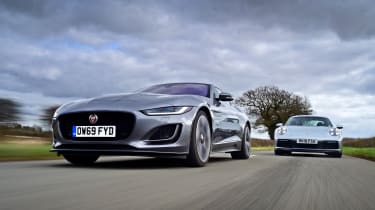
 Best performance cars 2020
Best performance cars 2020